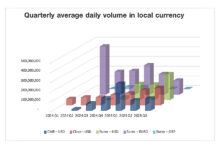The European bond market is under pressure from several dynamics which are shaping its evolution, with implications for investors and issuers.
Andy Hill, senior director in the International Capital Market Association’s (ICMA) market practice and regulatory policy group, believes market evolution remains driven by two key dynamics.
“It continues to be rather tough for traditional liquidity providers – with the notable exception of the very largest houses – feeling the pain of increasing capital costs and shrinking balance sheets, limiting their capacity to warehouse risk,” he said. “Additionally, the European bond market is witnessing an acceleration in technology and innovation to support trading.”
Evolving dynamics
Two notable ongoing developments are the continued growth of the fixed income exchange traded fund (ETF) market and improvements in algorithmic models.
The ETF market, supported by alternative liquidity providers, offers an alternative investment vehicle to access the bond market, whether wholesale or retail, and another means to transfer risk.
“The fact that it is a cash instrument, compared, say, to credit default swaps (CDS), makes it attractive to investors who are subject to strict limits on leverage,” Hill noted. “At the same time, increased ETF activity is helping to inject liquidity into underlying segments of the market, through the creation and redemption process, tightening bid-ask spreads and increasing velocity of turnover.”
In parallel, better algos are increasing automation, for dealer auto-pricing and buy-side valuations, plus smart auto routing and execution. This facilitates more all-to-all trading and buy-side price making.
“The flipside to this, perhaps, is that we are seeing a bifurcation of liquidity within different classes of the bond market, with some segments becoming more equity-like, trading in smaller clips at very tight prices, while other, less liquid segments become increasingly more difficult to trade. This is where buy-sides, and market makers, are having to work a lot harder, increasingly in collaboration. This is also where human skills and experience, and the value of trust and relationships, still matter,” Hill said.
Policy leg ups
There have been a number of market initiatives and policy measures designed to help improve market efficiency, liquidity and growth.
“On the policy side, if we are serious about fostering deeper market liquidity and resilience, we should review the Basel framework as it applies to market makers. This also includes the treatment of non-high quality liquid assets (HQLA) repo and single-name CDS. Anything else is dancing around the edges,” Hill said.
From a market perspective, there is potentially a need for innovation that can help build trust between the sell and buy side. As liquidity becomes stretched, market participants are increasingly worried about “revealing their hand”, especially when talking about less liquid segments or blocks.
“Finding new ways to communicate confidently and securely your interests or axes, without the fear of moving the market, would seem to be a useful development,” Hill added.
The need for enhanced communication tools is likely to increase with the arrival of the consolidated tape which will exacerbate nervousness around certain orders.
“Accordingly, the transparency focus is likely to shift from post-trade for small and liquid to pre-trade for large and illiquid,” Hill said.
©Markets Media Europe 2025












